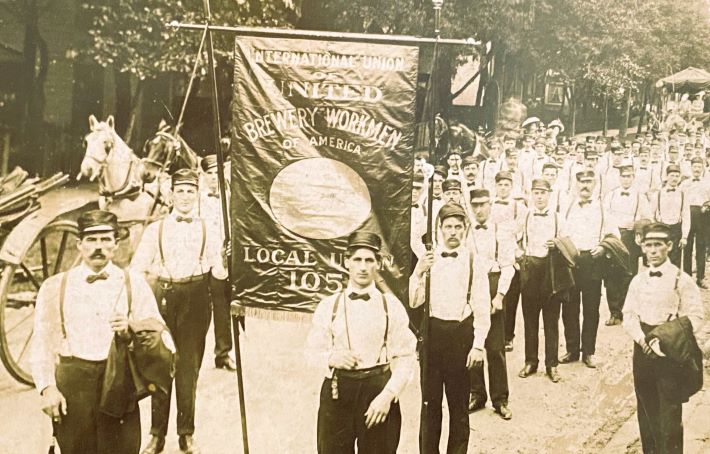
End of message

End of message

A few links before an upcoming hiatus that will continue until after the Great American Beer Festival. If you find yourself missing me, I’ll be there Oct. 11.
Were I inclined to take the time, which I am not, I would explain how the following links relate to a question I’ve been trying to make sense of for too long now. First I have to figure out how to properly phrase that question. Call it a work in progress.
– Tilray lays off 10 Barrel Brewing’s entire Innovation Brewing Team and Carnage at 10 Barrel. The usually wise Ron Pattinson once wrote, “I don’t want innovative beer.” I do.
– Craft Beer Can’t Afford to Be Local Anymore. Ahem, and not just because I wrote a book called “Brewing Local.” Local is still part of the DNA for, like, 90 percent of the small breweries in the country. Not 90 percent of the volume of craft beer sold, which is what this story is about.
Soon 30 years ago, Daria and I were standing on the former “killing floor” of a sausage factory that had become Left Hand Brewing with co-founder Eric Wallace (this was one of those times when you remember exactly where you were when you heard something). Wallace, who figures prominently in this VinePair story, said: “The large brewers are not tooled to do what we do. They’ll have to build less-than-efficient breweries to make beer like we do.”
I should, and will, maybe even at GABF, talk with Wallace about just what he meant when he said, “We can make your beer more efficiently.” I’m not prepared to abandon the thought embracing efficiency means abandoning inefficiency altogether. Or that innovation does not include what Tonya Cornett has been doing for so long in Oregon.
That’s already more than I meant to write this week. There are dots to be connected, but not now. Instead, a reminder that should you be jonesing for beer links between now and well into October visit A Good Beer Blog on Thursdays and Boak & Bailey on Saturdays.
 I promise you, I am properly embarrassed.
I promise you, I am properly embarrassed.
I will be among the “homebrew rockstars” pouring beer Oct. 11 at the Great American Beer Festival. Pouring a tripel that American Homebrewers Association director Julia Herz and I brewed in the festival hall will be fun. The part that makes me blush is being called a rock star.
Perhaps I should explain. Homebrew Headquarters for AHA Members takes the place, so to speak, of the annual homebrewers convention (also known at Homebrew Con). John Holl talked to Herz about the hiatus for an All About Beer podcast. It is fair to admit the decision was not universally positive. There are many things about a three-day conference that homebrewers truly enjoy.
I understand, but for a homebrewer there will be worse places to be Oct. 9-12 than Denver. Here’s the full lineup of AHA events, starting with Club Night Oct. 9. And there is way too much new at the festival itself to try to describe here.
The photo at the top is from the day we brewed the tripel at her house. That’s a bag of Pevec from Troubadour Maltings in Fort Collins, Colo. So there is more to explain. When Julia asked me to participate in HQ at AHA I suggested we brew a tripel in collaboration. I wrote the recipe in 2005, not long after I visited Belgium’s six (at the time) monastery breweries, plus a few others, while doing the research for “Brew Like a Monk.”

The biggest news last week was Teamsters Local 322 has requested Sapporo-Stone Brewing to recognize the union as the exclusive collective bargaining representative of Stone Brewing’s employees.
The Minnesota State Fair concludes today. I mention this because the World Brewing Congress, also in Minnesota, wrapped up only two days before the fair started. It was have been so nice to stick around for all manner of unique Fair Food, much of it fried. In recent years, the fair has added specialty drinks as well. Like Blueberry Pancake Lager, Purple Maize (after all, it is Minnesota), and Mini Donut Beer.
A few lists:
– Best fair food
– New fair food
– Returning specialty sips
– New specialty sips
– Drinks that almost happened
Makes glitter beers seem pretty tame.
QUOTE OF THE WEEK I
Also name of the week
“I think that the dirty little secret of Montana is that we like our beers a little sweeter than we want to admit. I mean, I love IPAs. I drink them all the time. But I think the biggest segment of drinkers like a slightly sweet, smooth beer. The commonality between a Coors Banquet and Cold Smoke is that they’re both a 10 IBU, malt-forward beer.”
— Al Pils
From More Than Just IPA: Across America, Craft Beer Has Surprising Pockets of Regionality
QUOTE OF THE WEEK II

I am enamored with the potential of question and answer format that Alan McLeod debuted last Thursday. I may give something similar a whirl one of these months. But given that this week’s dispatch is being filed from the Indianapolis International Airport, brevity wins.
POSTMODERN
Last week at the World Brewing Congress (where the photo above was taken), I don’t remember how the conversation turned to the proliferation of beer styles. But Dan Vollmer, senior manager product strategy & research at Boston Beer, said there must be a better way signal to drinkers what to expect from a beer. Samuel Adams best two seasonals, he said, are Octoberfest and Summer Ale. “They both tell you when to drink them,” he said.
Joe Stange started using the term postmodern beer in 2011, if not earlier, at the blog he called Thirsty Pilgrim. He elaborated on it in a 2015 post for Draft magazine (archived by the Wayback Machine). Now Courtney Iseman acknowledges “postmodernism has been a bit of a moving target in beer.”
LOCAL
In case you missed it, I wrote a book titled, “Brewing Local.” I have opinions about “local beer.”
A dozen years ago, this was the topic for The Session.
Last week, Jeff Alworth wrote, “What’s curious is how contingent that concept of local is.” It is, he admitted, a pretty bloggy blog post. One that invites comments (which he would appreciate), kind of like The Session, back in the day.
YOU MIGHT ALSO ENJOY
– “Thank You For Paying Black People” I’ve been disappointed not to come across more dispatches from Barrel & Flow 2024. As well as this field report, there was news Em Sauter has a new book, “Pairing Beer With Everything.”
– Not all tastemakers are vintners. Bow & Arrow Brewing CEO Shyla Sheppard and Crafted for Action founder Jen Price snuck into Wine Enthusiast’s wine-heavy Future 40 Tastemakers 2024.
– Because Jack D’Or lives on (you know if you know). The Beer Nut makes a pilgrimage to St Mars of the Desert. He also found Fantastico! “Anyone looking for juicy haze here will be disappointed. I have to say I liked this more serious and adult take on the style, one that isn’t trying to convince you it’s secretly a soft drink.”
– Mash like its 1893. And there is this, “Allegedly, some breweries add fir pitch to the kettle at a rate of 3-4 lb per 100 barrels of wort to impart a pitch flavour to the beer, as the lagering vessels are not pitched but only lacquered.”
– Speaking of local. The sale of Magnolia Brewing in San Francisco (again) means it will be locally owned (again).